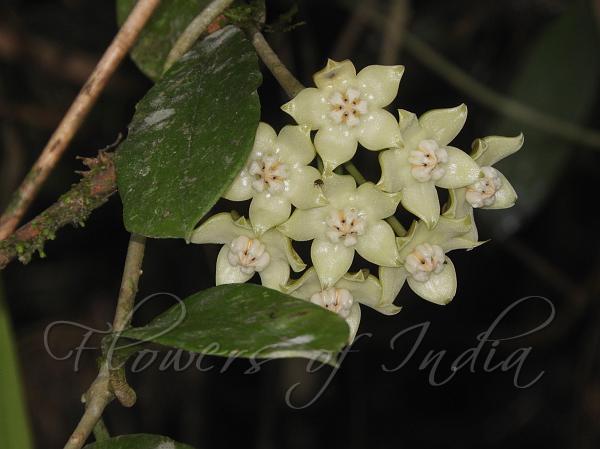|
| East-Himalayan Wax Flower |
|

|

| File size | 572627 |
| Original date | 8/5/22 10:19 AM |
| Resolution | 5184 x 3888 |
| Flash | Flash fired, auto |
| Focal length | 125.4mm |
| Exposure time | 1/125s |
| Aperture | 5.6 |
| Focus Distance | |
| Metering Mode | Multi-segment |
| Camera make | NIKON |
| Camera model | COOLPIX B700 |
| Sensor type |
|
|
|
|
Photo: |
Botanical name: Hoya griffithii Family: Apocynaceae (Oleander family)
Synonyms: Hoya kwangsiensis, Hoya lancilimba, Hoya tsoii
Synonyms: Hoya kwangsiensis, Hoya lancilimba, Hoya tsoii
East-Himalayan Wax Flower is a tree-dwelling shrub,
hairless throughout. Flowers are white, about 3 cm in across, petals
broadly ovate, somewhat cruved, spreading, hairless outside, obscurely
finely velvet-hairy inside. Corona lobes are about 5 mm, concave, outer
angle rounded, inner angle extending into a tooth as long as anther
appendages, to 3 mm. Flowers are borne in leaf-axils, in spherical
pseudo-umbels, carried on flower-cluster-stalk 5-7 cm. Flower-stalks
are 4-4.5 cm, sepals oblong-ovate, 7-8 x about 4.5 mm. Stems are up to
1.5 m. Leaf-stalk 1-3 cm, robust; leaf blade lanceshaped or
oblong-lanceshaped, 11-14 x 2.5-4.5 cm, papery, base wedge-shaped, tip
pointed to tapering; lateral veins few, obscure. Seedpods are
lanceshaped, about 15 x 1 cm. East-Himalayan Wax Flower is found in
dense or sparse forests, at altitudes of about 800 m, in NE India,
China, Laos, Vietnam. Flowering: June-August.
Medicinal uses: The stems and leaves are used
for the treatment of traumatic injury, fractures, swellings, and
coughs.
The stems and leaves are used
for the treatment of traumatic injury, fractures, swellings, and
coughs.
Medicinal uses:
 The stems and leaves are used
for the treatment of traumatic injury, fractures, swellings, and
coughs.
The stems and leaves are used
for the treatment of traumatic injury, fractures, swellings, and
coughs. | Identification credit: Dipanakar Borah | Photographed in Siang district, Arunachal Pradesh. |
• Is this flower misidentified? If yes,